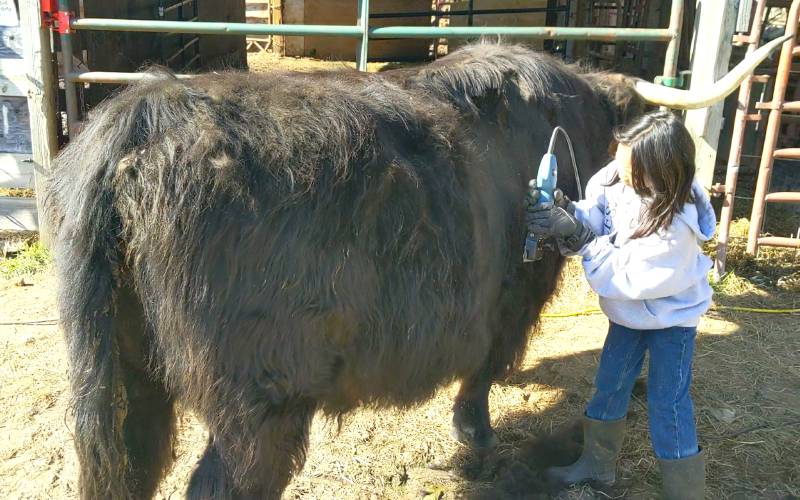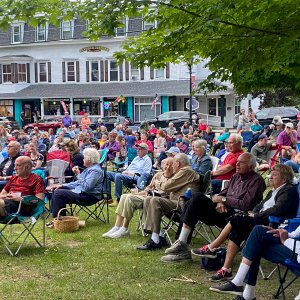From the farm: The Cow Spa is open

Clipping the steers (farmers call them bulls) gets them ready for the warm weather. Scottish Highland cattle, with double-thick coats, have no problem with cold weather, but if left on, some suffer in the summer heat. Here, Topper, a 12-year-old Scottish Highlander steer, lost about 5 pounds of hair on his spa day. If you’d like to try clipping, contact Carole at Miles Smith Farm to pick a date. CAROLE SOULE / For the Monitor
| Published: 04-27-2024 8:00 AM |
Clipping cows means warm weather is near. Cow clipping is an annual ritual at Miles Smith Farm. Scottish Highland and Belted Galloway cattle grow thick, rich coats of hair to protect them from frigid winter weather. The lanolin in their hair repels water and snow better than an L.L. Bean slicker. Unlike a parka, the cattle can’t remove their wooly coats when the weather warms up. That’s when electric clippers come into play.
By “cows,” I mean “cattle” of all genders and conditions of sexual viability. It’s not accurate, but it’s how I think of them.
Most of our cows are halter-trained, so we can catch them, tether them, and start clipping. The clippers’ vibration must be soothing because once the clipping begins, each cow will lower its head, close its eyes, and fall into a trance. Even cows who have not been handled will stand quietly in the squeeze chute, lulled into submission as we buzz away their winter covering.
There’s another benefit of clipping. Each year, we treat all of the cattle for parasites. Just as you apply flea and tick medicine on your dog or cat, we do the same for each cow. The dosage is more, but the concept is the same. Highland hair is so thick some of the creepy insects survive the winter. After clipping, their home is gone, and so are they.
What do we do with the hair? Is it useful like wool? Cow hair is more like human hair and does not weave or bind like wool. A few years ago, a farm friend collected softer hair from our young cattle. She made a “poor man’s blanket” by mixing the hair with wool. Cattle hair might keep the cow warm, but unlike wool, it is difficult to weave and has minimal insulating value when woven; it was a lousy blanket and an exercise not worth repeating.
So, we leave the hair for birds to collect as they build nests.
Not all of the cattle need clipping. Some older cows naturally shed, and we remove the loose hair with some vigorous brushing. Cattle love the brushing.
Last year, when farm friend David Leach stopped brushing our riding steeer, Curious Bleu, the beast would reach around with his horns and nudge David as if to say, “C’mon, bro, keep brushing.” Everyone loves spa day.
Article continues after...
Yesterday's Most Read Articles
 New Hampshire legalizes public alcohol consumption in designated ‘social districts’
New Hampshire legalizes public alcohol consumption in designated ‘social districts’
 State rules Epsom must pay open-enrollment tuition to other school districts, despite its refraining from the program
State rules Epsom must pay open-enrollment tuition to other school districts, despite its refraining from the program
 Town turmoil: Chichester town administrator resigns again
Town turmoil: Chichester town administrator resigns again
 New Hampshire providers brace for Medicaid changes that reach beyond healthcare
New Hampshire providers brace for Medicaid changes that reach beyond healthcare
 Warner town administrator granted restraining order against selectman
Warner town administrator granted restraining order against selectman
 NH judge decides to pause Trump’s birthright citizenship order
NH judge decides to pause Trump’s birthright citizenship order
Unfortunately (or not), my allergies have removed me from barber duty. On clipping day, I’m in charge of bringing the bovines to the clipping station, replacing dull clipper blades, and disposing of the clipped hair.
Please stop by the farm during store hours (Friday and Saturday from 10 a.m. to 4 p.m.) for a self-guided farm tour (there is a fee for adults, and children are free.) And stop by to see our “naked cows” and meet our newborn calves. Three calves have been born already, and we expect four more joy bundles! If you’d like to clip one of our hairy beasts, email me at msf.places@gmail.com.
Carole Soule is co-owner of Miles Smith Farm (www.milessmithfarm.com), where she raises and sells beef, pork, eggs, and other local products. She can be reached at carole@soulecoaching.com. Carole also coaches humans, helping them achieve the impossible a little at a time.







 Lavender haze: Purple fields bloom at Warner farm
Lavender haze: Purple fields bloom at Warner farm Arts in the Park returns for July
Arts in the Park returns for July Hopkinton art gallery showcases “Creativity Beyond Convention”
Hopkinton art gallery showcases “Creativity Beyond Convention” AROUND CONCORD: Your guide to free summer music
AROUND CONCORD: Your guide to free summer music
